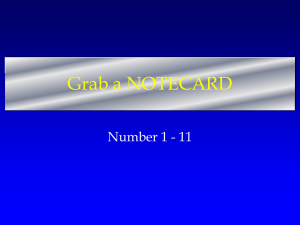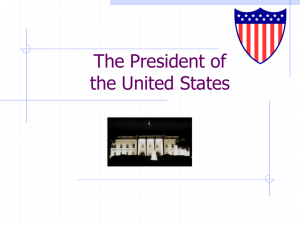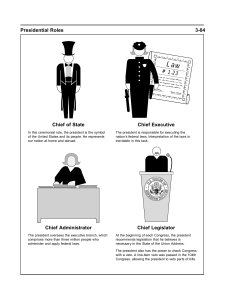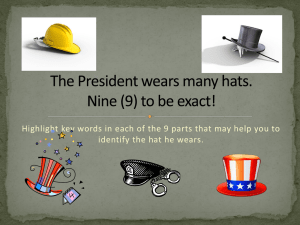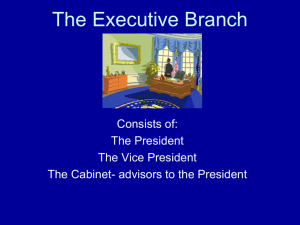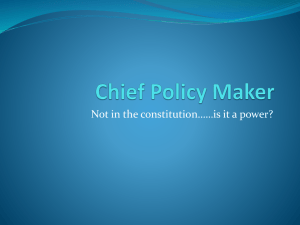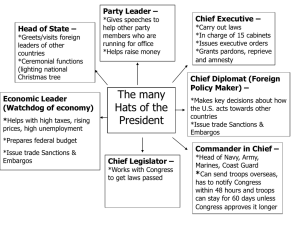Role: Chief of State
advertisement
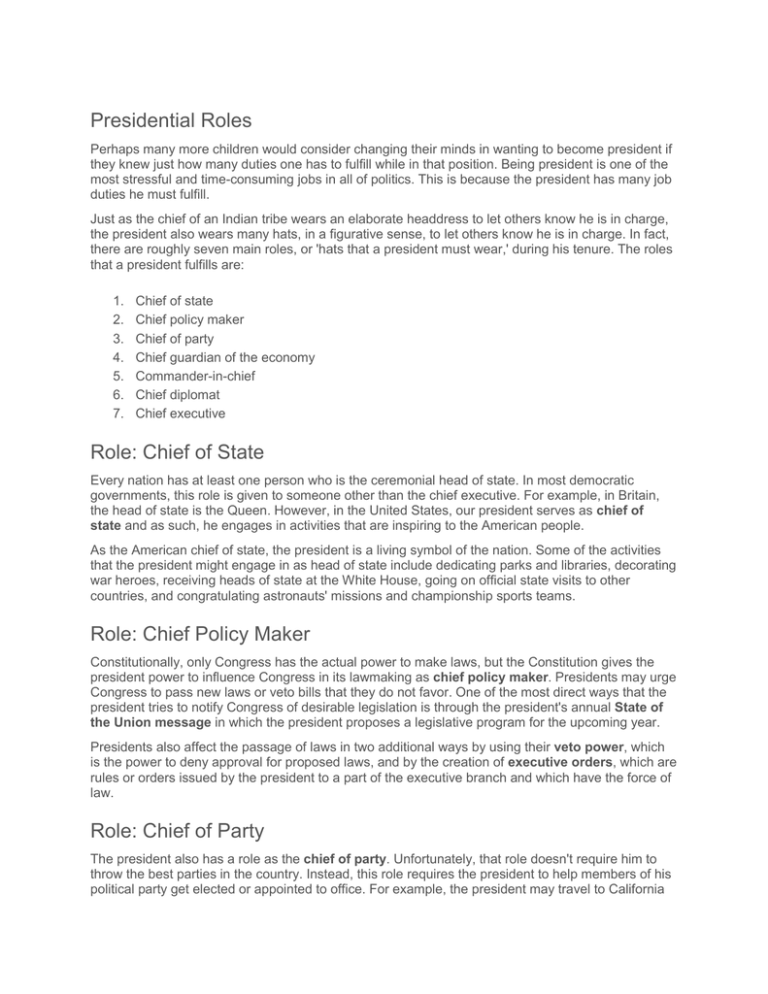
Presidential Roles Perhaps many more children would consider changing their minds in wanting to become president if they knew just how many duties one has to fulfill while in that position. Being president is one of the most stressful and time-consuming jobs in all of politics. This is because the president has many job duties he must fulfill. Just as the chief of an Indian tribe wears an elaborate headdress to let others know he is in charge, the president also wears many hats, in a figurative sense, to let others know he is in charge. In fact, there are roughly seven main roles, or 'hats that a president must wear,' during his tenure. The roles that a president fulfills are: 1. 2. 3. 4. 5. 6. 7. Chief of state Chief policy maker Chief of party Chief guardian of the economy Commander-in-chief Chief diplomat Chief executive Role: Chief of State Every nation has at least one person who is the ceremonial head of state. In most democratic governments, this role is given to someone other than the chief executive. For example, in Britain, the head of state is the Queen. However, in the United States, our president serves as chief of state and as such, he engages in activities that are inspiring to the American people. As the American chief of state, the president is a living symbol of the nation. Some of the activities that the president might engage in as head of state include dedicating parks and libraries, decorating war heroes, receiving heads of state at the White House, going on official state visits to other countries, and congratulating astronauts' missions and championship sports teams. Role: Chief Policy Maker Constitutionally, only Congress has the actual power to make laws, but the Constitution gives the president power to influence Congress in its lawmaking as chief policy maker. Presidents may urge Congress to pass new laws or veto bills that they do not favor. One of the most direct ways that the president tries to notify Congress of desirable legislation is through the president's annual State of the Union message in which the president proposes a legislative program for the upcoming year. Presidents also affect the passage of laws in two additional ways by using their veto power, which is the power to deny approval for proposed laws, and by the creation of executive orders, which are rules or orders issued by the president to a part of the executive branch and which have the force of law. Role: Chief of Party The president also has a role as the chief of party. Unfortunately, that role doesn't require him to throw the best parties in the country. Instead, this role requires the president to help members of his political party get elected or appointed to office. For example, the president may travel to California to speak at a rally for a party nominee to the U.S. Senate. In other words, the president campaigns for those members who have supported his policies and may appoint leading party members to serve in the Cabinet. At the end of a term, the president may campaign for reelection. Just as we look out for our friends, the president looks out for his. Role: Chief Guardian of the Economy As chief guardian of the economy, the president is concerned with such things as unemployment, high prices of consumer goods, taxes, business profits, and the general prosperity of the country. While the president does not control the economy, he is expected to help it run smoothly. He can do this by doing such things as meeting with economic advisers to discuss ways to reduce unemployment or by discussing their overall needs and problems. Role: Commander in Chief One of the most powerful roles that the president has is commander in chief of our nation's armed forces. The president is in charge of all U.S. armed forces: the Army, Navy, Air Force, and Marines. The president decides where troops shall be stationed, where ships shall be sent, and how weapons shall be used. All military generals and admirals take their orders from the president. Role: Chief Diplomat The president's role as chief diplomat allows the president to decide what American diplomats and ambassadors shall say to foreign governments, and with the help of advisers, makes the foreign policy of the United States. The president can also negotiate and propose treaties with other nations, but they must officially be ratified by Congress. Role: Chief Executive The last role that a president serves comes as the 'big cheese,' or boss, of the executive branch. As his role as chief executive, the president decides how the laws of the United States are to be enforced and chooses officials and advisers to help run the executive branch. For example, the president might appoint someone to serve as head of the Central Intelligence Agency, or CIA. Lesson Summary In our system of government, the president is the focal point of our federal government where the head of government (the president) leads an executive branch that is separate from a legislative branch, and who also serves as the head of state called the presidential system of government. As head of the government, the president serves seven roles, including: 1. 2. 3. 4. 5. 6. 7. Chief of state Chief policy maker Chief of party Chief guardian of the economy Commander-in-chief Chief diplomat Chief executive

